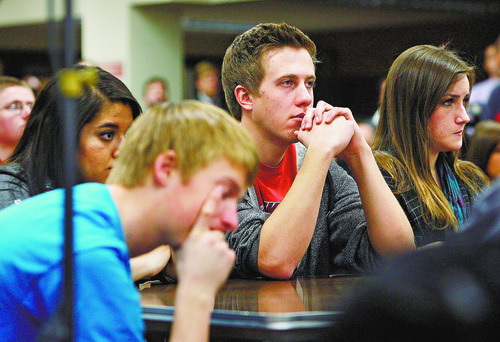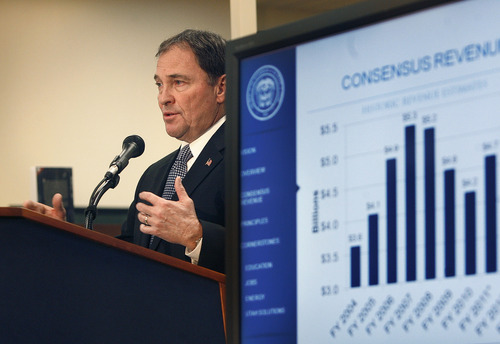This is an archived article that was published on sltrib.com in 2011, and information in the article may be outdated. It is provided only for personal research purposes and may not be reprinted.
Bountiful • Gov. Gary Herbert pitched his budget blueprint for the coming year as a plan that ensures Utah has an educated workforce that attracts business and fuels economic growth.
At its heart, Herbert's proposal is an increase of more than $134 million for Utah's public schools and universities to educate 12,500 students entering public schools next year and offering teachers a small raise.
"I think it is absolutely imperative for our long-term economic stability that we fund education," Herbert said. "It's the linchpin. I can't develop energy and all the potential that's there ... you can't do that without education and research. We can't have a healthy economy and job growth and creation without an educated workforce."
The school infusion absorbs about a third of the total $408 million in new spending in Herbert's $12.9 billion budget proposal.
Health care costs eat up much of the remainder with a spike in Medicaid and the Children's Health Insurance Program — which provide health care to Utah's poor — costing the state nearly $163 million more in the coming year.
The governor's recommendation is merely the first step in the budget process. Ultimately, the decisions will be made by the Legislature, which historically has given little deference to the governor's suggestions, although lawmakers Monday were generally favorable toward Herbert's blueprint.
"Twelve billion dollars is a lot of money," said Senate President Michael Waddoups, R-Taylorsville, who has specific concerns about growth in particular areas.
Waddoups said he is concerned about $6 million the governor is seeking for the University of Utah medical school, and he thinks higher education funding should be cut elsewhere. There are also concerns about some of the public education spending beyond the enrollment growth.
"Our priority is education ... that's where we're going to succeed in coming out of this recession," Waddoups said, but the total education package Herbert proposes "makes us really nervous."
House Speaker Becky Lockhart, R-Provo, said she believes the governor's recommendation is "a good budget. I think it's a conservative budget and it considers the needs of the state."
But Utah Democratic Party Chairman Jim Dabakis said the budget reflected tired, old ideas and half-measures for Utah's education system, which remains last in the nation in per-pupil spending.
"We are screaming out to the Governor and the Republican Legislature to give a damn about Utah kids," Dabakis said. "Stop the rhetoric and spend some money to build our children a better future and a better Utah."
Herbert is offering a tax break for employers, cutting their unemployment insurance tax by a total of $26.4 million. The governor said the cut would benefit 88 percent of small businesses and stimulate private-sector hiring.
The governor is putting forward $500,000 for homeless shelters, another area that Waddoups questions.
"Is that where the state is supposed to be spending its money or are we supposed to be providing a way for people to get out of that situation?" Waddoups asked.
The unemployment trust fund plummeted from more than $800 million to less than $300 million during the recession, but Department of Workforce Services director Kristen Cox said the fund is growing again and the tax can be cut without cutting benefits or breaking the fund.
Senate Minority Leader Ross Romero, D-Salt Lake City, said with the efficiencies already squeezed out of Workforce Services, he isn't sure how the department will meet the unemployment demand.
"If we're not funding unemployment then the bridge for those who need it isn't there," Romero said. "I'm uncertain how you can provide the same benefits with less money."
Herbert is recommending a 1 percent pay hike for state workers and teachers who haven't seen a raise since 2007. The state would also cover increased health premiums.
Higher education — which has seen a 29 percent enrollment spike and a 17 percent dip in funding — will see little relief.
"The best we could do this year is to hold them harmless and give them an additional $3 million for growth," Herbert said.
Herbert did not seek to pay down any of Utah's debt, nor did he recommend any new building or road projects. Republican legislators have been pressing to reduce the debt, which is at record levels, about $1,200 for every Utahn.
"I think absolutely it's a priority," said Senate budget chairman Lyle Hillyard, R-Logan. "The bonding level is higher than I feel comfortable with."
Customarily legislators have not exceeded 85 percent of the state's constitutional debt limit, but the state's debt has crept up to 87 percent of that level. It would cost $85 million to get back down to 85 percent.
"That's one of the things we're going to be concerned about," Lockhart said. "We want to look at reducing the debt load. ... With the incompetent federal government, they have put all of the state budgets at risk, so we have to be very cautious about the kind of decisions we make."
She said if automatic cuts to the federal budget kick in next year "states will bear the brunt of those reductions."
Herbert said he agrees the state's debt is too high and he didn't approve of additional borrowing the Legislature did at the end of last session in order to build buildings. If lawmakers want to pay that debt, they could adopt a recommendation he made last year to require self-employed Utahns to file their taxes quarterly instead of annually.
While there are no new buildings proposed in the governor's budget, $60 million is earmarked for maintenance.
Hillyard said the state's building board has recommended projects that would cost $289 million, including $100 million at the University of Utah alone.
Twitter: @RobertGehrke —
Herbert's budget primer
Here are some additional highlights of Gov. Herbert's budget proposal.
• $4 million to lease beds from county jails to alleviate crowding in the prison system;
• $11 million for a Parole Violator Center, a low-security facility for parolees who violate terms of their release, rather than returning them to prison. That 300-bed center is due to open in April 2012;
• Hiring six new Utah Highway Patrol troopers;
• $2.8 million to sustain cash-strapped state parks and a $1 million reduction in tourism promotion to $6 million;
• $2.4 million to keep open the doors of state liquor stores — some of which were threatened with closure last year;
• $760,000 for the Governor's Office of Energy Development;
• A $13.5 million payment toward settling the Pelt lawsuit, which alleged that the state had mismanaged the oil royalties of 8,000 Navajos.





